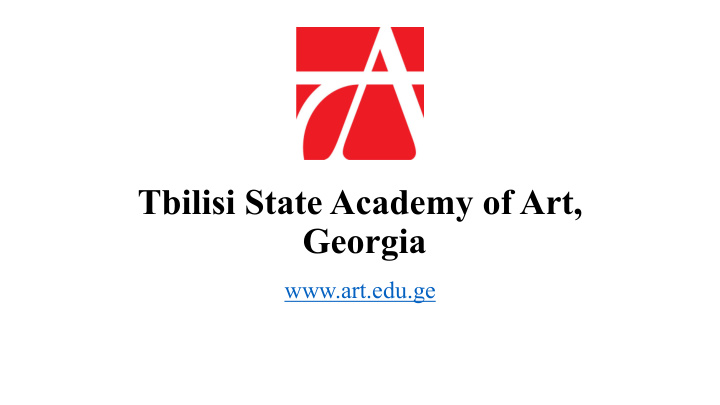



Tbilisi State Academy of Art, Georgia www.art.edu.ge
Tbilisi State Academy of Arts - facade
The Tbilisi State Academy of Art was founded in 1922. At present, it can be seen as a possible attractive partner, representing the country with multi- cultural intersections and diverse artistic expressions, basing on traditional knowledge linked with contemporary approach. Ever since its foundation, it has been located in a Palace - the Monument of Cultural Heritage, constructed in the middle of the XIX century. Academy’s artistic appearance is especially valuable and has an eclectic character: The facade is typically European, though in the building’s interior the Baroque style co-exists with elements of late Classicist and late Iranian – so called Qajar styles.
Academy’s historic building, beginning of the XX century Guest–room Mirror Halls
Academy’s historic building, beginning of the XX century Ball-room Art studio
Academy’s historic building, beginning of the XXI century
Academy’s historic building, beginning of the XXI century
Academy’s historic building, beginning of the XXI century
Academy’s historic building - ornamental motifs from Eastern miniatures.
Academy’s historic building - murals introducing ornamental motifs from Eastern miniatures.
Currently, professional, BA, MA and PhD studies at the Tbilisi State Academy of Art involve about 1 700 students. The academy is governed by the Rector, the Academic Board and the Representative Board.
Big Exhibition Hall
Five faculties operate at the academy, those of: - Visual Art, - Architecture, - Design, - Restoration/Art History and Theory, - Media Art The original art education curricula are created on a basis of bridging rich traditions and contemporary approach. In order to achieve the goal of being relevant to modern world requirements, as well as, compatible with the common European space of higher art education, the academy’s vector for Internationalization strategy is directed towards strengthening of cooperation with the leading European higher art education institutions, becoming involved into international joint projects, comprehensive development of international exchange projects within Erasmus+ program and bilateral/multilateral agreements, for sharing academic and creative experience, etc.
Faculty of Visual Art comprises three directions: • Painting - Easel Painting - Theatre Arts (Scenography) - Cinema-TV Arts • Graphics: - Easel Graphics Studio - Book Design and Illustration Studio - The Poster Design Studio - Advertising Graphics Studio - Animation Studio • Sculpture • Drawing (optional service)
Faculty of Visual Art – Department of Painting
Faculty of Visual Art – Department of Sculpture
Faculty of Fine Art – Department of Graphics, Poster studio
Faculty of Visual Art – Department of Drawing (optional service)
Faculty of Architecture: Bachelor’s degree directions : • Civil Architecture • Space Design • Interior Design Master’s Degree directions : • Civil Architecture • City Planning • Environmental Design • Interior Design • Architectural Design of Color and Lighting • Urban Architecture • Landscape Architecture
Faculty of Architecture - Interior design, Environmental design, Civil architecture
Faculty of Restoration, Art history and theory: • Direction of Art History and Theory • Direction of Restoration/Conservation Special emphasis is set on the art historian - historical, technological, and diagnostic research of the cultural heritage artefacts (architecture, painting, metal, glass and ceramic ), as well as, on studies of the original and conservation materials, preventative measures, fundamentals of conservation theory, philosophy and legislation, professional ethics.
Faculty of Restoration/Art History and Theory
Faculty of Restoration/Art History and Theory – Restoration/conservation laboratory
The Faculty of Design comprise 8 directions: • Artistic Ceramics • Artistic Glass • Textile Design • Fashion Design • Industrial Design • Artistic Processing of Wood and Furniture Design • Jewellery and Metal Decorative Plastics • Research Laboratory of Blue Table-Cloth
Faculty of Design Artistic Glass Fashion Design
Artistic Ceramics Wood and Metal Decorative Plastics
Experimental Research Laboratory “Lurji Supra” (Blue Table-Cloth). The laboratory restored ancient Georgian tradition of patterned cloth printing, dating back to XVI century. The cotton and silk blue tablecloths, napkins and head-dresses are hand-printed by traditional cold cube dyeing method, as well as, modern photophilous printing.
The Faculty of Media Art comprises three directions: • Digital media - Computer 2D and 3D modeling and design, - Computer multimedia, - Web-design, - Computer animation • Graphic design and visual communications • Photography
Faculty of Media art - Digital media, Graphic design, Photography
International Relations Department The priority is to advance and support university’s Internationalization strategy, integration of TSAA with an international scientific and educational area. As a part of university’s policy towards internationalization, there are some of the goals: Widening the networks of cooperation and strengthening the links with the leading • international institutions and foundations (British Council, Goethe Institute, French Institute, etc.), having a profile relevant to TSAA artistic, academic, and scientific priorities, Participation in international scientific and academic life with a purpose of sharing • knowledge and experience, support of the students for participation in international exhibitions and competitions, Development of the long and short-term joint educational and art projects with active • involvement of students, Inviting international academic professionals and artists for master classes, workshops, • seminars, conferences, etc., Support and improvement of the students, academic staff mobility within Erasmus+ program • and bilateral/multilateral agreements.
Tbilisi State Academy of Art
Recommend
More recommend